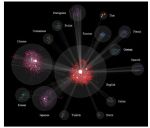EPJ B Highlight - Predicting collective online behaviour
- Details
- Published on 18 June 2013

A team of Chinese scientists evaluates the impact of a website based on the interaction between its users with the entire Web
A new study shows that small websites, in terms of daily user flux based on number of clicks, have a disproportionally high impact when it comes to traffic generation and influence compared to larger websites. These findings, just published in EPJ B, have implications for estimating the value of sites and related advertising revenue. They result from the work of Lingfei Wu from the City University of Hong Kong and Jiang Zhang from the School of Management, at Beijing Normal University, China.
Previous studies have analysed hyperlinks, while individual browsing records provide insight for understanding local surfing behaviour. However, they fail to provide information on more internet-wide collective browsing behaviour. Hence, to understand the complex interactions between websites, it is necessary to analyse the transportation of traffic, referred to as the flow of clickstreams between websites.
In this study, the authors analyse the clickstream networks composed of the 1,000 most popular websites. They rely on models of clickstream networks based on so-called Markov matrices. They then validate their findings through network flow analysis, tracking users’ movement.
Wu and Zhang found that the accessibility of websites in the clickstream network increases more slowly than the level of traffic for the sites studied. Unlike previously thought, this study based on clickstreams reveals that the web is not solely dominated by a few hubs. And relatively small sites have a greater chance of acquiring popularity than larger ones. They do not follow the so-called “rich-get-richer” paradigm, suggesting that user navigation increases the inequality of traffic among websites.
This study offers a more precise calculation of the impact of sites for calculating advertising rates, for example, based on the circulation of clickstreams, instead of being based on traffic.
L. Wu and J. Zhang (2013), The Decentralized Flow Structure of Clickstreams on the Web , European Physical Journal B, DOI 10.1140/epjb/e2013-40132-2




